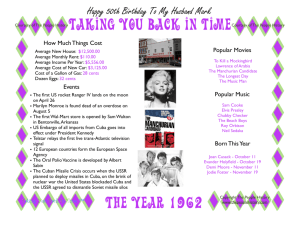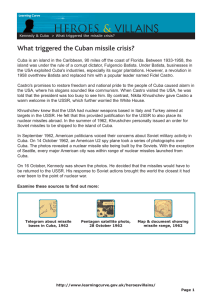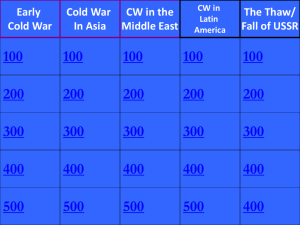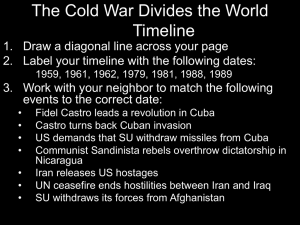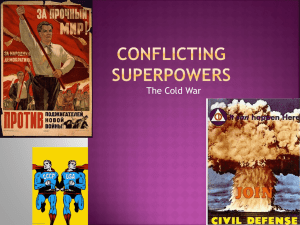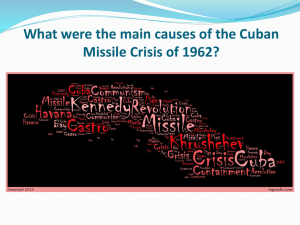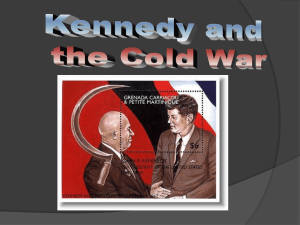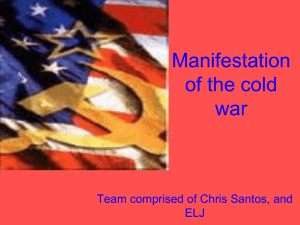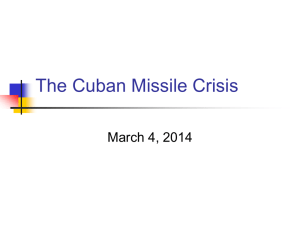The Cold War: Brinkmanship & Collapse
advertisement
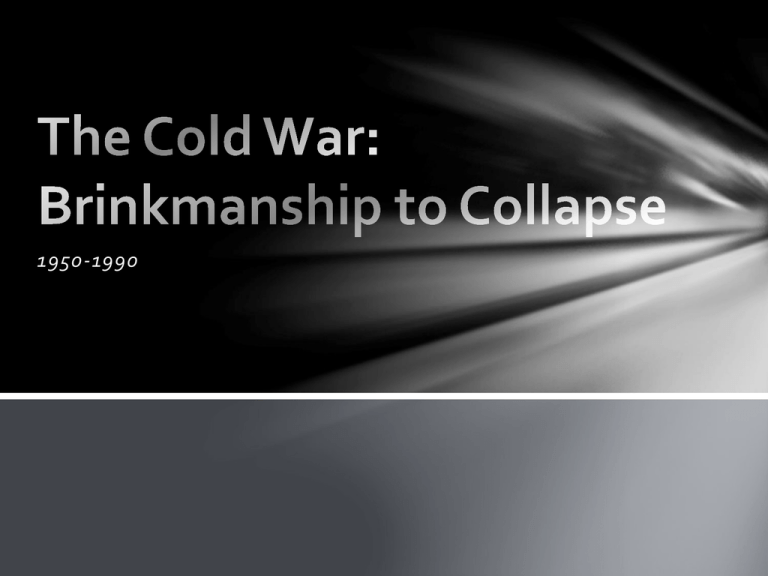
1950-1990 Nuclear Arms Race US Uses A-Bomb in 1945 •Soviets test A-bomb in 1949 •Each side wants more than the other. •Brinkmanship-Two Countries going to the edge of War •M.A.D-Mutual Assured Destruction SPACE RACE •A dual purpose •ICBM (Intercontinental Ballistic Missle) • Sputnik (1957) •Yuri Gargarin (1961)-Soviet Hero •Soviet victories embarrassed the U.S. Revolution in Cuba • Batista was leader of Cuba and backed by the U.S. • Fidel Castro started a revolution in 1956, in Jan. of 1959 Batista fled Cuba and Castro took over. Bay of Pigs • U.S.A. President Kennedy wanted to overthrow Castro’s govt. • The CIA trained Cuban exiles (nationalists) to invade Cuba. • Apr. 17th, 1961 1,300 exiles (with US weapons) landed at the Bahia de Cochinos (Bay of Pigs). • They were captured by Castro’s Army. Cuban Missile Crisis • Cuba was afraid of a 2nd invasion so Castro agreed to let Khrushchev (the Soviets Premier) place Soviet missiles aimed at the U.S. in Cuba. • A spy plane took pictures of the missile silos being built. • Kennedy began to prepare for War if the ICBMs were not removed. U.S. Soviet Stand-off Kennedy decided to surround Cuba to stop the Soviets from send the missiles by placing a Quarantine. The Russian ships were coming, the U.S. Navy was not going to let them through….. WWIII was about to happen. This is called brinkmanship = the willingness to the edge of war. End of the Cuban Missile Crisis Thankfully, war was avoided. (the Soviets agreed to send their ships back to the U.S.S.R.) The Soviets agreed to not put missiles in Cuba. The U.S. took missiles out of Turkey and promised not to invade Cuba. But tensions remained between USSR & USA The Cold War Thaws Growing cooperation between the U.S. and USSR •The ‘hot line’ •Increased trade •Tourism and cultural exchanges The Cold War Thaws Emergence of Detente • Nixon (U.S.) and Brezhnev (USSR) • Period of decreased tension • Reversal from brinkmanship • High point: Nixon’s visits to China and the USSR • Results: • SALT I treaty limited number of nuclear missiles • Helsinki Accords: promise of cooperation The Cold War Heats Back Up Reagan abandons détente • Star Wars (SDI) becomes a symbol of American antiCommunism • Increased military spending antagonizes USSR New Leadership 1985: Gorbachev in power • Reformer • No connection to Stalin/old ideas Social reform through openness: Glasnost • Increased freedom Economic reform through restructuring: Perestroika • communism more efficient/productive Political reform through democratization • Parliamentary elections Foreign Policy • End arms race (can’t afford) Spirit of Reform Spreads Poland • 1989: government agrees to free elections Hungary • 1980s: economic reforms • 1989: new constitution • Communist party disbanded Spirit of Reform Spreads Czechoslovakia Oppressive government arrests dissidents in 1989 Leads to popular protest and government crackdown Huge protests in Prague force government to resign Romania Most oppressive, last to reform 12/25/89: Ceausescu overthrown and executed Spirit of Reform Spreads East Germany • 1989: leave through Hungary’s open borders • 11/9/89: the Wall is opened • Communists voted out One Germany • 10/3/90: Germany is • reunited Collapse of the USSR Lack of economic progress under Gorbachev • June 1991: USSR holds free elections • Boris Yeltsin elected President • Gorbachev critic, popular mayor of Moscow Coup attempt • Hard-liners afraid of reform capture Gorbachev, order army to attack Parliament • Failure, Communist Party collapses • Republics declare independence • Gorbachev resigns, Commonwealth of Independent States (CIS) formed Collapse of Yugoslavia Ethnic conflict creates problems • 6 ethnic groups, religious differences, mixed populations Milosevic makes Serbia dominant • Croatia, Slovenia declare independence • Bloody civil war, but succeed • Bosnia: most ethnically mixed • Independence leads to war and ethnic cleansing of Muslims Problems continue
